Zixing Lei
PolySim: Bridging the Sim-to-Real Gap for Humanoid Control via Multi-Simulator Dynamics Randomization
Oct 02, 2025Abstract:Humanoid whole-body control (WBC) policies trained in simulation often suffer from the sim-to-real gap, which fundamentally arises from simulator inductive bias, the inherent assumptions and limitations of any single simulator. These biases lead to nontrivial discrepancies both across simulators and between simulation and the real world. To mitigate the effect of simulator inductive bias, the key idea is to train policies jointly across multiple simulators, encouraging the learned controller to capture dynamics that generalize beyond any single simulator's assumptions. We thus introduce PolySim, a WBC training platform that integrates multiple heterogeneous simulators. PolySim can launch parallel environments from different engines simultaneously within a single training run, thereby realizing dynamics-level domain randomization. Theoretically, we show that PolySim yields a tighter upper bound on simulator inductive bias than single-simulator training. In experiments, PolySim substantially reduces motion-tracking error in sim-to-sim evaluations; for example, on MuJoCo, it improves execution success by 52.8 over an IsaacSim baseline. PolySim further enables zero-shot deployment on a real Unitree G1 without additional fine-tuning, showing effective transfer from simulation to the real world. We will release the PolySim code upon acceptance of this work.
Self-Localized Collaborative Perception
Jun 18, 2024
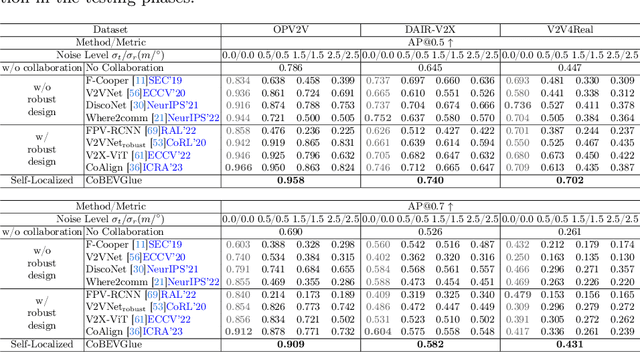


Abstract:Collaborative perception has garnered considerable attention due to its capacity to address several inherent challenges in single-agent perception, including occlusion and out-of-range issues. However, existing collaborative perception systems heavily rely on precise localization systems to establish a consistent spatial coordinate system between agents. This reliance makes them susceptible to large pose errors or malicious attacks, resulting in substantial reductions in perception performance. To address this, we propose~$\mathtt{CoBEVGlue}$, a novel self-localized collaborative perception system, which achieves more holistic and robust collaboration without using an external localization system. The core of~$\mathtt{CoBEVGlue}$ is a novel spatial alignment module, which provides the relative poses between agents by effectively matching co-visible objects across agents. We validate our method on both real-world and simulated datasets. The results show that i) $\mathtt{CoBEVGlue}$ achieves state-of-the-art detection performance under arbitrary localization noises and attacks; and ii) the spatial alignment module can seamlessly integrate with a majority of previous methods, enhancing their performance by an average of $57.7\%$. Code is available at https://github.com/VincentNi0107/CoBEVGlue
Robust Collaborative Perception without External Localization and Clock Devices
May 05, 2024



Abstract:A consistent spatial-temporal coordination across multiple agents is fundamental for collaborative perception, which seeks to improve perception abilities through information exchange among agents. To achieve this spatial-temporal alignment, traditional methods depend on external devices to provide localization and clock signals. However, hardware-generated signals could be vulnerable to noise and potentially malicious attack, jeopardizing the precision of spatial-temporal alignment. Rather than relying on external hardwares, this work proposes a novel approach: aligning by recognizing the inherent geometric patterns within the perceptual data of various agents. Following this spirit, we propose a robust collaborative perception system that operates independently of external localization and clock devices. The key module of our system,~\emph{FreeAlign}, constructs a salient object graph for each agent based on its detected boxes and uses a graph neural network to identify common subgraphs between agents, leading to accurate relative pose and time. We validate \emph{FreeAlign} on both real-world and simulated datasets. The results show that, the ~\emph{FreeAlign} empowered robust collaborative perception system perform comparably to systems relying on precise localization and clock devices.
Emergent Communication in Interactive Sketch Question Answering
Oct 24, 2023
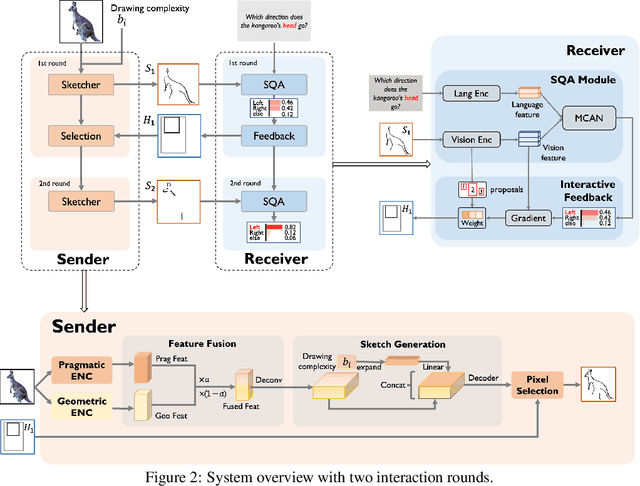

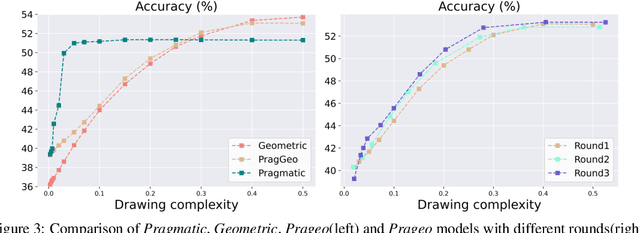
Abstract:Vision-based emergent communication (EC) aims to learn to communicate through sketches and demystify the evolution of human communication. Ironically, previous works neglect multi-round interaction, which is indispensable in human communication. To fill this gap, we first introduce a novel Interactive Sketch Question Answering (ISQA) task, where two collaborative players are interacting through sketches to answer a question about an image in a multi-round manner. To accomplish this task, we design a new and efficient interactive EC system, which can achieve an effective balance among three evaluation factors, including the question answering accuracy, drawing complexity and human interpretability. Our experimental results including human evaluation demonstrate that multi-round interactive mechanism facilitates targeted and efficient communication between intelligent agents with decent human interpretability.
Interruption-Aware Cooperative Perception for V2X Communication-Aided Autonomous Driving
Apr 24, 2023Abstract:Cooperative perception enabled by V2X Communication technologies can significantly improve the perception performance of autonomous vehicles beyond the limited perception ability of the individual vehicles, therefore, improving the safety and efficiency of autonomous driving in intelligent transportation systems. However, in order to fully reap the benefits of cooperative perception in practice, the impacts of imperfect V2X communication, i.e., communication errors and disruptions, need to be understood and effective remedies need to be developed to alleviate their adverse impacts. Motivated by this need, we propose a novel INterruption-aware robust COoperative Perception (V2X-INCOP) solution for V2X communication-aided autonomous driving, which leverages historical information to recover missing information due to interruption. To achieve comprehensive recovery, we design a communication adaptive multi-scale spatial-temporal prediction model to extract multi-scale spatial-temporal features based on V2X communication conditions and capture the most significant information for the prediction of the missing information. To further improve recovery performance, we adopt a knowledge distillation framework to give direct supervision to the prediction model and a curriculum learning strategy to stabilize the training of the model. Our experiments on three public cooperative perception datasets demonstrate that our proposed method is effective in alleviating the impacts of communication interruption on cooperative perception.
Where2comm: Communication-Efficient Collaborative Perception via Spatial Confidence Maps
Sep 26, 2022



Abstract:Multi-agent collaborative perception could significantly upgrade the perception performance by enabling agents to share complementary information with each other through communication. It inevitably results in a fundamental trade-off between perception performance and communication bandwidth. To tackle this bottleneck issue, we propose a spatial confidence map, which reflects the spatial heterogeneity of perceptual information. It empowers agents to only share spatially sparse, yet perceptually critical information, contributing to where to communicate. Based on this novel spatial confidence map, we propose Where2comm, a communication-efficient collaborative perception framework. Where2comm has two distinct advantages: i) it considers pragmatic compression and uses less communication to achieve higher perception performance by focusing on perceptually critical areas; and ii) it can handle varying communication bandwidth by dynamically adjusting spatial areas involved in communication. To evaluate Where2comm, we consider 3D object detection in both real-world and simulation scenarios with two modalities (camera/LiDAR) and two agent types (cars/drones) on four datasets: OPV2V, V2X-Sim, DAIR-V2X, and our original CoPerception-UAVs. Where2comm consistently outperforms previous methods; for example, it achieves more than $100,000 \times$ lower communication volume and still outperforms DiscoNet and V2X-ViT on OPV2V. Our code is available at https://github.com/MediaBrain-SJTU/where2comm.
Latency-Aware Collaborative Perception
Jul 25, 2022

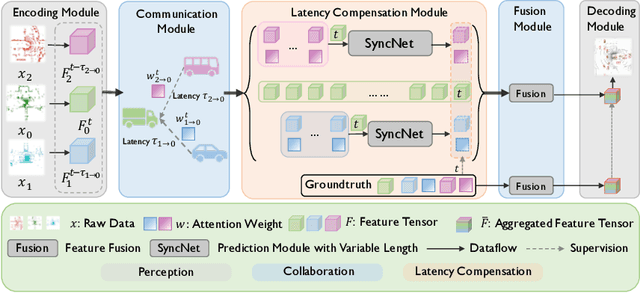
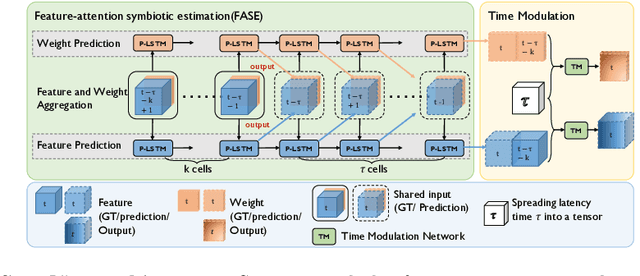
Abstract:Collaborative perception has recently shown great potential to improve perception capabilities over single-agent perception. Existing collaborative perception methods usually consider an ideal communication environment. However, in practice, the communication system inevitably suffers from latency issues, causing potential performance degradation and high risks in safety-critical applications, such as autonomous driving. To mitigate the effect caused by the inevitable latency, from a machine learning perspective, we present the first latency-aware collaborative perception system, which actively adapts asynchronous perceptual features from multiple agents to the same time stamp, promoting the robustness and effectiveness of collaboration. To achieve such a feature-level synchronization, we propose a novel latency compensation module, called SyncNet, which leverages feature-attention symbiotic estimation and time modulation techniques. Experiments results show that the proposed latency aware collaborative perception system with SyncNet can outperforms the state-of-the-art collaborative perception method by 15.6% in the communication latency scenario and keep collaborative perception being superior to single agent perception under severe latency.
 Add to Chrome
Add to Chrome Add to Firefox
Add to Firefox Add to Edge
Add to Edge